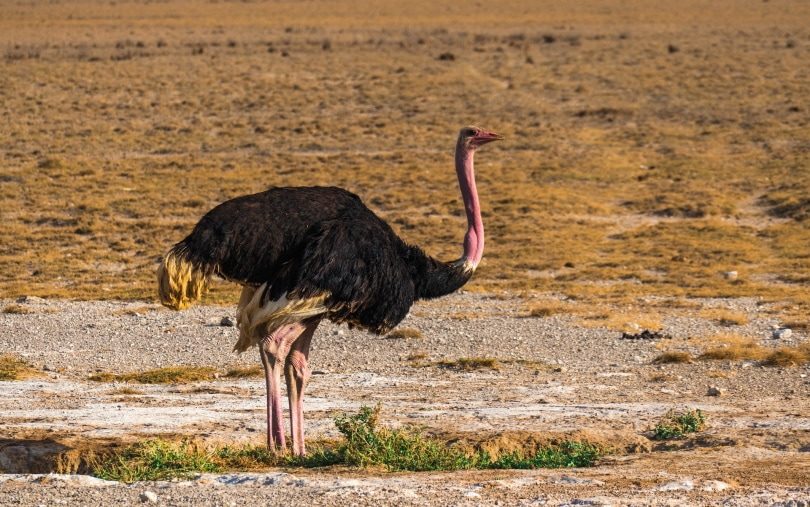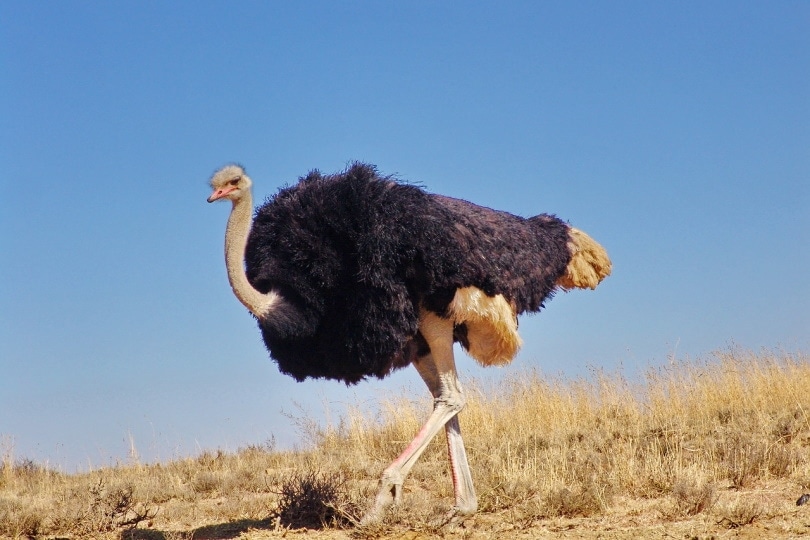North African Ostrich: Facts, Uses, Origins & Characteristics (with Pictures)
Last Updated on

The North African Ostrich, also known as the Red-Necked Ostrich or the Barbary Ostrich, is the largest living bird in the world. It is the closest living relative to the now-extinct Arabian Ostrich.

The Earliest Records of the North African Ostrich in History
The North African Ostrich once had a widespread habitat across Africa. However, habitat destruction and hunting have caused steep declines in the North African Ostrich population. Nowadays, they’re thought to only exist in small pockets in Chad, Cameroon, the Central African Republic, and Senegal.
While North African Ostriches were once common in Southern Tunisia, they were rendered extinct in the area for over 100 years until wildlife conservationists reintroduced the birds into national parks. Today, the North African Ostrich can be found in three national parks in Tunisia but remains extinct in the wilds of Tunisia but can be found in the Dghoumès and Sidi Toui National Parks, and the Orbata Faunal Reserve.
How North African Ostriches Gained Popularity
North African Ostriches have gained popularity amongst animal conservation efforts because of their steeply declining population. Animal conservation authorities have worked to reintroduce North African Ostriches to their former natural habitats, including new areas of Chad and Tunisia, to bolster the wild populations of the birds.
One huge factor of the popularity boost for the North African Ostrich has been ostrich riding, which is usually done with common ostriches rather than North African Ostriches.
Ostrich chicks are also adorable and rather cuddly. So, people have taken in the recent interest in saving them.

North African Ostrich Reintroduction Efforts
The North African Ostrich once had an expansive habitat across Africa. However, hunting and habitat destruction have rendered the animal critically endangered. Reintroduction efforts have been largely successful. North African Ostriches now have small, protected habitats in Tunisia, Morocco, and Sahara.
Additionally, the North African Ostrich is being reintroduced to locations where the Arabian Ostrich once walked. Red-Necked Ostriches were documented in the Arabah Desert, Eilat Mountains, and Negev Desert.
Introduction to Saudi Arabia’s Mahazat as-Sayd Protected Area began in 1994 and their reintroduction to the Al-Khunfah Protected Area has been planned. It’s currently estimated that 90–100 individuals live in the Mahazat as-Sayd Protected Area.
The North African Ostrich has also been introduced to Israel’s Yotvata Hai-Bar Nature Reserve and there are plans to release some in the fields of the Negev Desert. However, the reintroduction of the species failed here as the reintroduced birds vanished. The authority believes that the birds voluntarily left the area to travel to Egypt or the Nahal Seifim.
- See also: Is an Ostrich a Bird or a Mammal?

Top 3 Unique Facts About the North African Ostrich
https://www.instagram.com/p/BeALm9hAn6R/
1. Mitochondrial DNA proves that the North African Ostrich is the closest living relative to the now-extinct Arabian Ostrich.
Analysis of mitochondrial DNA shows that the North African Ostrich is the closest living relative to the Arabian Ostrich. This analysis was used to fuel the reintroduction of the North African Ostrich in West Asia.
2. The North African Ostrich is being reintroduced to its former habitats as well as habitats of the Arabian Ostrich.
Reintroduction of the North African Ostrich to its former African habitats has been very successful and there has been limited success in reintroducing the North African Ostrich to West Asia.
3. Ostriches were once kept as pets during the Bronze Age in Mesopotamia.
In Bronze Age Mesopotamia, keeping ostriches as exotic pets was common amongst the nobles. Ostrich hunts were common in Assyria and kings and queens would keep ostriches in zoos to harvest them for eggs and feathers.
Does the North African Ostrich Make a Good Pet?
https://www.instagram.com/p/Bxj6omYgt8u/
Ostriches do not make good pets. While the chicks may be cute and cuddly, an adult ostrich is a dangerous animal that should not be kept in captivity as a pet. Ostrich domestication has not been successful and male ostriches are known for becoming highly aggressive as they age. Keeping an ostrich as a pet is illegal in most of the United States and it should remain illegal.
Further, keeping a North African Ostrich as a pet would be a crime because the species is considered critically endangered.
Ostrich farming is far more common, though the ostrich market is variable at best. Ostrich farms harvest the ostriches for feathers, meat, hides, and eggs. It’s estimated that there are only a few hundred Ostrich farms in the United States.

Conclusion
Ostriches have boomed in popularity because of widespread conservation efforts but keeping them as a pet is an ill-advised and dangerous move. Pet parents who are considering an ostrich chick should steer clear of these giant birds.
Featured Image Credit: DukeAsh, Pixabay
Table of Contents
- The Earliest Records of the North African Ostrich in History
- Top 3 Unique Facts About the North African Ostrich
- 1. Mitochondrial DNA proves that the North African Ostrich is the closest living relative to the now-extinct Arabian Ostrich.
- 2. The North African Ostrich is being reintroduced to its former habitats as well as habitats of the Arabian Ostrich.
- 3. Ostriches were once kept as pets during the Bronze Age in Mesopotamia.
- Does the North African Ostrich Make a Good Pet?
- Conclusion
About the Author Luxifa Le
Luxifa is a freelance writer with a passion for animal science and technology. She loves to share the world of animal science with people to help them make informed decisions for themselves and their pets. Knowledge is power and she loves to help everyone become the most informed they can be.
Related Articles:
Monocular vs Telescope: Differences Explained (With Pictures)
10 Types of Hummingbirds in Arkansas (With Pictures)
8 Types of Hummingbirds in Nebraska (With Pictures)
5 Types of Hummingbirds in Idaho (With Pictures)
3 Types of Hummingbirds in Mississippi (With Pictures)
8 Types of Hummingbirds in Kansas (With Pictures)
5 Types of Hummingbirds in West Virginia (With Pictures)
5 Types of Hummingbirds in Ohio (With Pictures)
